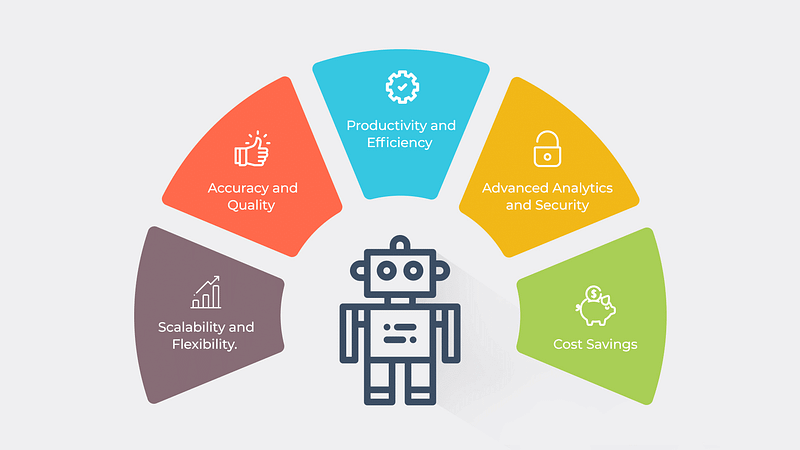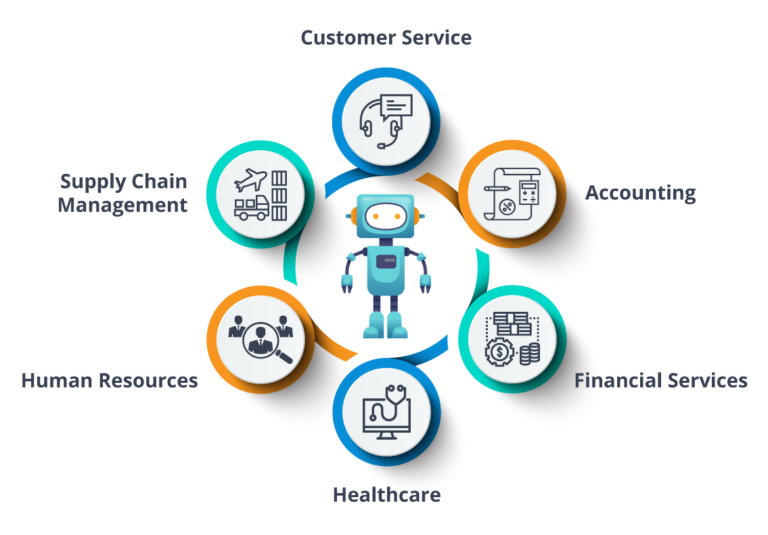Robotic Process Automation
Robotic process automation (RPA) is a software technology that makes it easy to build, deploy, and manage software robots that emulate humans actions interacting with digital systems and software. Just like people, software robots can do things like understanding what’s on a screen, complete the right keystrokes, navigate systems, identify and extract data, and perform a wide range of defined actions. But software robots can do it faster and more consistently than people, without the need to get up and stretch or take a coffee break.

Benefits of RPA
There are multiple benefits of RPA, including:
1. Less coding
2. Rapid cost savings
3. Higher customer satisfaction
4. Improved employee morale
5. Better accuracy and compliance
6. Existing systems remain in place

Why is RPA the fastest-growing enterprise software in the world?
When you combine RPA’s quantifiable value with its ease of implementation relative to other enterprise technology, it’s easy to see why RPA adoption has been accelerating worldwide.
RPA can help many different types of industries address their specific operational issues in new and powerful ways.
Leaders of functional areas from finance to customer service to marketing to human resources and beyond find that RPA improves many processes, yielding higher capacity, faster throughput, and fewer errors for key processes.
From a CFO’s perspective, an investment in RPA technology delivers rapid ROI and requires minimal upfront spending compared to other enterprise technology.
IT executives find that RPA can be implemented with little disruption. And because software robots can easily access and work within legacy systems, RPA has become a key enabler for digital transformation. And modern RPA technology offers scalable, enterprise-ready platforms.
Employees find that it’s easy to adopt robotic assistants into their workdays and that RPA’s low-code approach lets them become citizen developers who can build their own simple automation
Top Ten tips for effective robotic process automation
1. Set and manage expectations
2. Consider business impact
3. Involve IT early and often
4. Poor design, change management can wreak havoc
5. Don’t fall down the data rabbit hole
6. Project governance is paramount
7. Control maintains compliance
8. Build an RPA center of excellence
9. Don’t forget the impact on people
10. Put RPA into your whole development lifecycle
Robotic Process Automation and IBM
Automating processes is just one important step forward as the need for automation widens across business and IT operations. A move toward greater automation should start with small, measurably successful projects, which you can then scale and optimize for other processes and in other parts of your organization.
Working with IBM, you’ll have access to AI-powered automation capabilities, including prebuilt workflows, to help accelerate innovation by making every process more intelligent.
Take the next step:
1. Start your automation journey with IBM® Robotic Process Automation. It’s an AI-driven RPA solution that helps you automate more business and IT processes at scale with the ease and speed of traditional RPA.
2. Watch this product overview demo (04:03) to see how you can use IBM Robotic Process Automation to build an unattended bot to handle common use cases, such as updating customer information.
3. Try IBM Robotic Process Automation for no cost for 30 days to learn how to build and run software bots or virtual agents to automate processes.
4. IBM Robotic Process Automation can also come integrated with automation capabilities such as content, capture, workflow, and decisions as part of IBM Cloud Pak for Business Automation, a flexible set of integrated software that helps you design, build and run intelligent automation services and applications on any cloud, using low-code tools at scale.
5. Read Robotic Process Automation: A “no-hype” buyer’s guide to learn what RPA is, its pros and cons, and how to get started.

Robotic process automation (RPA) is a software technology that makes it easy to build, deploy, and manage software robots that emulate humans actions interacting with digital systems and software.
ReplyDeleteThanks for sharing an informative blog; I really enjoyed reading your well written articles.
Lube Oil Blending Plant, Lube Oil and Grease Filling Line